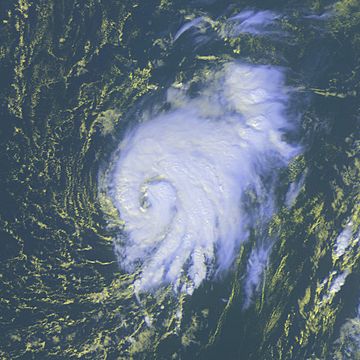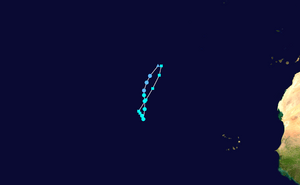Tropical Storm Peter (2003) facts for kids
| Tropical storm (SSHWS/NWS) | |

Tropical Storm Peter near peak intensity
|
|
| Formed | December 7, 2003 |
|---|---|
| Dissipated | December 11, 2003 |
| Highest winds | 1-minute sustained: 70 mph (110 km/h) |
| Lowest pressure | 990 mbar (hPa); 29.23 inHg |
| Fatalities | None reported |
| Damage | None |
| Areas affected | No land areas |
| Part of the 2003 Atlantic hurricane season | |
Tropical Storm Peter was a tropical storm that didn't last very long. It formed after the official end of the Atlantic hurricane season in 2003. Peter started as a different kind of storm called an extratropical storm.
At first, it was a subtropical cyclone, which is a mix between a tropical and an extratropical storm. But as it moved over warmer ocean waters, it started to get stronger. On December 9, 2003, it officially became a tropical cyclone. It even developed an eye, which is a clear center often seen in strong hurricanes. Peter almost became a hurricane itself! It reached its strongest winds of 70 mph (110 km/h). However, strong wind shear (winds blowing in different directions) and cooler waters quickly made Peter lose its strength.
Contents
How Tropical Storm Peter Formed and Moved
A large weather system, an extratropical cyclone, began forming on December 2. It was in the eastern Atlantic Ocean, far southwest of the Azores islands. This system first moved northwest, then north, and later northeast. By December 4, it had strong winds, like a gale.
Later that day, it changed into a low-pressure system with a weather front. Because of high pressure in the northeast Atlantic, the storm turned southeast. On December 7, it turned south-southwest. Thunderstorms then started to form around its center.
Peter Becomes a Subtropical Storm
Experts believe the system became a subtropical storm late on December 7. It was located about 835 miles (1340 km) south-southwest of the Azores. The storm then moved southwest over warmer waters.
The thunderstorms, also called convection, around the storm kept getting stronger. These thunderstorms became more concentrated near the center. Rainbands, which are spiral bands of rain, also started to form around the storm's center.
Peter Becomes a Tropical Storm
Because the storm was gaining so much strength, the National Hurricane Center officially named it Tropical Storm Peter. This happened on December 9. At that time, Peter was about 980 miles (1580 km) northwest of Praia in the Cape Verde islands.
Before Peter even formed, weather forecasts had predicted that a storm might develop. When Peter became a tropical storm, it was moving very slowly. Early predictions thought it would quickly disappear.
Peter's Peak and Weakening
However, an eye quickly formed in Peter's center. This showed it was getting stronger. Peter reached its strongest winds of 70 mph (110 km/h) late on December 9. Even though it had an eye and strong winds, Peter stayed a strong tropical storm. It did not become a hurricane.
Soon after reaching its peak, Peter started to weaken quickly. It moved northward because of a cold front. The combination of strong wind shear and cooler ocean water temperatures rapidly weakened the storm. By December 10, Peter had become a tropical depression, which is a weaker type of storm.
As the system turned northeast, Peter changed back into an extratropical storm on December 11. Shortly after this, it was completely absorbed by the cold front.
Peter's Impact and Special Records
Tropical Storm Peter stayed over the open Atlantic Ocean for its entire life. This means it never reached land. Because of this, no one was hurt and there was no damage.
Rare December Storms
Peter formed in December, which is very unusual for an Atlantic storm. Most storms happen between June and November. Another storm, named Odette, also formed in December of the same year. This made the 2003 Atlantic hurricane season the first time since 1887 that two storms developed in December!
Longest Season and "P" Names
Peter also helped make the 2003 season one of the longest. There were 235 days between the first storm, Tropical Storm Ana, and Peter, the last storm. This made 2003 the longest season since 1952.
Peter is also one of only four Atlantic tropical cyclones to ever reach the "P" name. This is because storms are named in alphabetical order each season. The official naming of hurricanes began in 1950.
Other pages
|
Tropical cyclones of the 2003 Atlantic hurricane season |
|||||||||||||||||||||||||||||||||||||
|
|
||||||||||||||||||||||||||||||||||||
|
|
|||||||||||||||||||||||||||||||||||||
Images for kids
-
Damage from Hurricane Fabian on Bermuda



